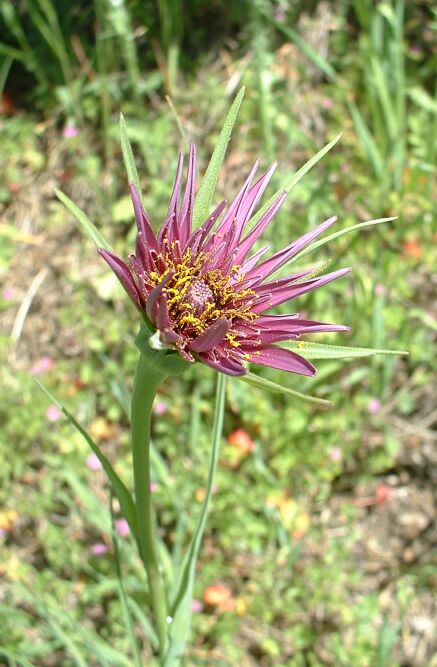- Purple Salsify
Taxobox
name = Purple Salsify

image_width = 250px
regnum =Plant ae
divisio = Magnoliophyta
classis = Magnoliopsida
ordo =Asterales
familia =Asteraceae
genus = "Tragopogon "
species = "T. porrifolius"
binomial = "Tragopogon porrifolius"
binomial_authority = L.Purple Salsify, "Tragopogon porrifolius", is one of the most widely known species of the
salsify genus . It is also known as Oyster Plant, Vegetable Oyster, or Common Salsify, or simply as Goatsbeard or Salsify - though as these last names are also applied to other members of the genus, or to the genus as a whole, they are better avoided.Purple Salsify is a common wildflower, native to Mediterranean regions of Europe but introduced elsewhere, for example, into
Great Britain and northern Europe,North America , and southernAfrica ; in theUnited States it is now found growing wild in almost every state, includingHawaii , except in the extreme south-east.The plant grows to around 60cm in height. As in other goatsbeards, its stem is largely unbranched, and the leaves are somewhat grasslike. In Britain it flowers from June to September, but in warmer areas such as
California it can be found in bloom from April. The flower head is about 5cm across, and each is surrounded by green bracts which are longer than the petals (technically, the ligules of the ray flowers). The flowers arehermaphrodite , and pollination is byinsect s.The root, and sometimes the young shoots, of Purple Salsify are used as a vegetable, and historically the plant was cultivated for that purpose; it is mentioned by classical authors such as
Pliny the Elder . Cultivation in Europe began in the 16th century inFrance andItaly . In Great Britain it was initially grown for its flower and later became a mildly popular vegetable in the 18th century but then declined in popularity. It is not a popular or very well known food item in the United States. Presently the root is cultivated and eaten most frequently in France, Italy andRussia . However in modern times it has tended to be replaced bySpanish Salsify or Black Salsify as a cultivated crop. Cultivated varieties include 'White French', 'Mammoth Sandwich Island' and 'Improved Mammoth Sandwich Island'; they are generally characterised by larger or better-shaped roots. The root becomes discolored and spoils quickly if broken, which can easily happen since it is difficult to remove from the soil without damage. The root is noted for tasting ofoyster s, from which the plant derives its alternative name of Oyster Plant; young roots can be grated for use in salads, but older roots are better cooked, and they are usually used in soups or stews. It is recommended that when using the root that, if cut, its color be preserved in acidulated water. Alatex derived from the root can be used as achewing gum . The flowering shoots can be used likeasparagus , either raw or cooked, and the flowers can be added to salad, while the sprouted seeds can be used in salads or sandwiches.The plant has also been used in
herbalism , also since classical times (it is mentioned byDioscorides ), and is claimed to have beneficial effects on theliver andgall bladder . The root is regarded as adiuretic .References
*Davidson, Alan. Oxford Companion to Food (1999), “Salsify”, p. 686. ISBN 0-19-211579-0
External links
* [http://ucjeps.berkeley.edu/cgi-bin/get_JM_treatment.pl?609,1938,1940 Jepson Manual treatment of the species]
* [http://elib.cs.berkeley.edu/cgi/img_query?where-genre=Plant&testing=123&rel-taxon=contains&where-taxon=&rel-namesoup=contains&where-namesoup=oyster+plant&where-lifeform=any&rel-location=like&where-location=&rel-country=eq&where-country=any&rel-state=eq&where-state=any&where-county=any&where-collectn=any&rel-photographer=eq&where-photographer=any&rel-kwid=equals&where-kwid= Images from the CalPhotos archive]
* [http://www.ibiblio.org/pfaf/cgi-bin/arr_html?Tragopogon+porrifolius&CAN=LATIND Plants for a Future database entry]
Wikimedia Foundation. 2010.
